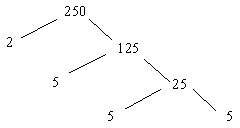 username@email.com
username@email.com
In this lesson, you will study and apply the Fundamental Theorem of Arithmetic and theoretic number concepts of primes, factors, and multiples.
The Fundamental Theorem of Arithmetic states that every positive integer (except the number 1) can be represented in exactly one way apart from rearrangement as a product of one or more prime numbers. Basically, this means that any number (except 1) can be broken down into its prime factorization.
How do I find the prime factorization of a number?
The prime factorization of a number is made up of all the numbers’ divisors that are prime numbers.
To find the prime factorization of a number, create a factor tree.

The prime factorization of 250 is 2 · 5 · 5 · 5.
Which of the following shows the correct prime factorization of 120?
The LCM stands for the least common multiple of a set of numbers. It is the smallest number that is a multiple of all numbers in a set.
To find the LCM, first find the prime factorization of each number in the set. Then look for the greatest number of times each factor appears in any of the factorizations. Multiply these together to find the LCM.
Find the LCM of 4, 6, and 18.

Which number is the LCM of 12, 21, and 24?
The correct answer is B. First, find the prime factorization of each number in the set.

Then look for the greatest number of times each factor appears in any of the factorizations. The LCM is 2 · 2 · 2 · 3 · 7 = 168.
The GCF stands for the greatest common factor of a set of numbers. It is the largest number that is a factor of all numbers in a set.
To find the GCF, first find the prime factorization of each number in the set. Then look for all numbers that appear in all lists. Multiply these numbers to find the GCF. If there are no common prime factors, the GCF of the set is 1.
Find the GCF of 30, 50, and 70.

What is the GCF of 18, 30, and 42?
The correct answer is A. First, find the prime factorization of each number.

Since both 2 and 3 appear in all three factorizations, the GCF is 2 · 3 = 6.
Remember that the LCM will be no smaller than the largest number in the set. The GCF will be no bigger than the smallest number in the set.